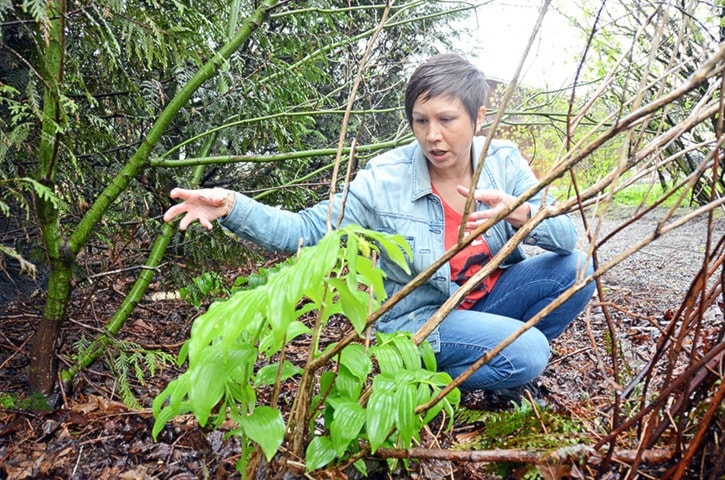If all of our food distribution systems were to shut down suddenly due to some cataclysmic natural disaster, few people would know how to take care of themselves once stores ran out.
Carrielynn Victor is one of those people.
“We are very fragile,” the young woman tells me while touring the Sto:lo Ethnobotanical Garden at the Sto:lo Nation grounds last week.
“We have something like four days with the pharmacies and the grocery stores if the system shuts down. We really have to be able to survive and we are fortunate to have rich mountainsides.”
Victor is interested in the medicinal qualities of various plants found in the region, but she is increasingly focused on food security and what’s beyond our backyard, the grocery store, the system.
This Saturday, Victor and Helena Paul are offering a tour of the Sto:lo community garden and the ethnobotancial garden to teach visitors about traditional Sto:lo foods.
The ethnobotanical garden was created in 1996 to illustrate the importance of plants to the Sto:lo. Most of the trees, shrubs and herbaceous plants are native to Sto:lo territory, some are plentiful in the wild while others are hard to find due to invasive species and encroachments by development.
Victor walks around the garden, observing what is “popping up” on this day. A vine maple sprouts fresh leaves. Burdock spreads weed-like on the edge of a garden bed. Solomon’s Seal bursts forth where days before there was none. Sword ferns begin to unfurl, just days past the edible fiddlehead stage.
Victor walks to the pond in the garden and asks what “beautiful food” I see.
“Nobody really picks it out because we see it all the time and don’t know it’s food,” she says. “The cattail.”
When the common marshy plant is just three or four inches out of the water, you can wiggle them out, peel off the outer two layers and eat them.
“It looks like a leek, tastes like a cucumber,” she says. “It’s fresh, quite tasty.”
Unlike the way most modern food is purchased and consumed, traditional Sto:lo foods often take a great deal of preparation. That and they are around for such a brief time, drying and preserving skills are essential.
(See Victor's family recipe for a dried fish soup below.)
Victor is a young woman who speaks in the calm, measured and knowledgeable tones of an elder. She is passionate about wild foods as a nutrition source, one that is integral to our species and our continued existence on the planet.
“I like to talk about integral relationships with plants,” she explains. “Where you are practising a relationship with the plant where we understand that we are the needy beings. We are the neediest beings on Earth and plants are millions of years older than us.
“When we acknowledge that relationship with them, they become our oldest ancestors.”
When it comes to talking about traditional Sto:lo foods, we can’t overlook the staple, the mainstay culturally and nutritionally: Salmon. And with this season’s expected run of sockeye predicted to be as large as four years ago in 2010, there is anticipation in the community.
“There is definitely an air of excitement to have fish this year,” Victor says, but she is quick to add that the Sto:lo are cautious in their optimism.
Between Fisheries and Oceans Canada’s misunderstanding of Sto:lo needs, poor early spring salmon runs, and the long-term pressures on fish in the Fraser River, Victor says they are praying there will be salmon for the long-term.
“The Sto:lo community are saying we shouldn’t look at any more five-year plans. We should be looking at the 500-year plan and where we fit in that as generations of people and how to nurture back the generations of the salmon that are feeding us.”
• The Sto:lo Traditional Foods event with Helena Paul and Carrielynn Victor is April 26 from 11 a.m. to 3 p.m. at the Sto:lo Resource Centre, 7201 Vedder Rd. There will be a traditional Sto:lo welcome, presentations by Victor and Paul, a tour of the gardens followed by a lunch of salmon, bannock and some traditional foods by donation. Visit the new website www.stolotourism.com for more information.

Carrielynn’s family dried fish soup recipe
Eating in a traditional way is about eating what’s available when it’s available. Victor says that with some of the old recipes, the things that are ready at the same time also happen to go together perfectly. For example, when the Sto:lo are in the Fraser Canyon and dried fish is ready, so to are the Pacific crabapples and wild onions.
The fourth ingredient you might not find, so bring your own camas bulbs, which are a traditional potato-like food of the Sto:lo.
Put it all together to make a soup: dried fish, crab apple, wild onion and camas.
“It’s fabulous,” she says. “”There is something about the crab apple and the onion together, the broth is amazing.”
